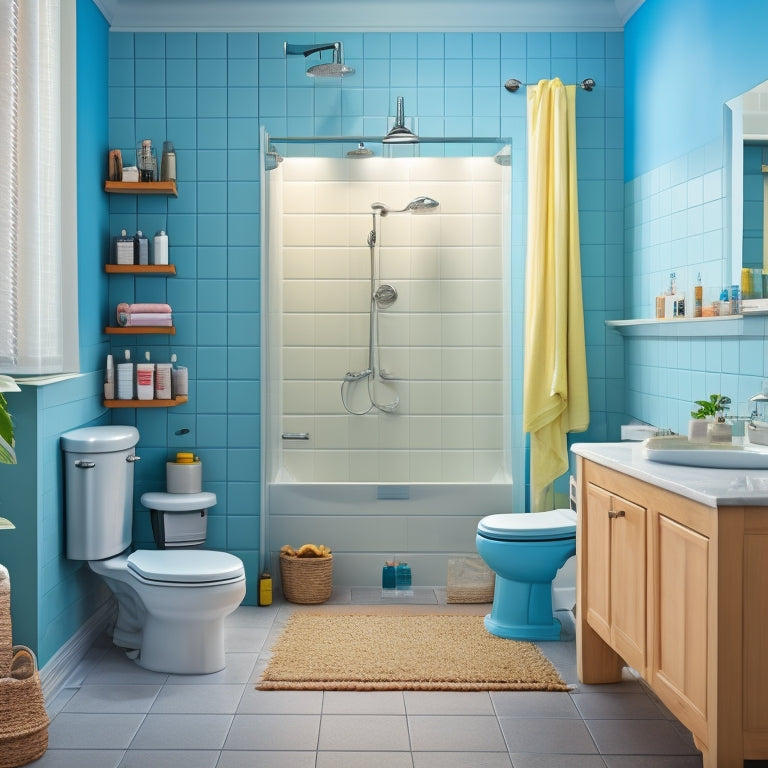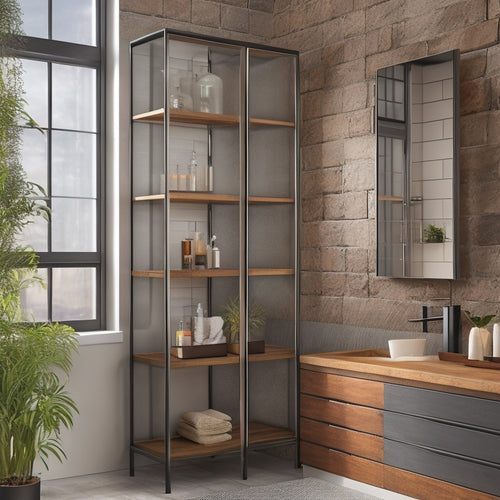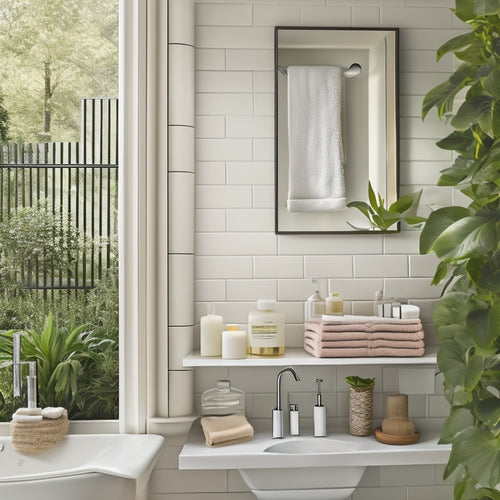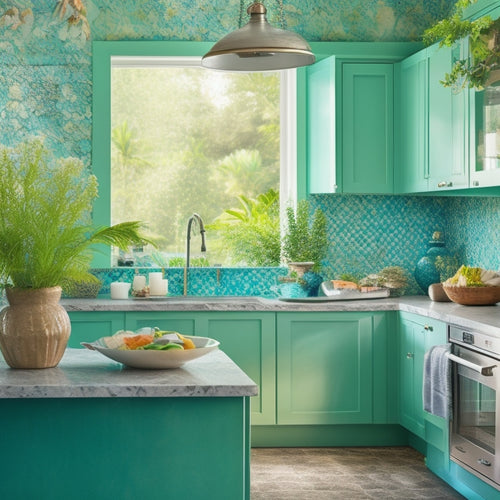
10 Steps to Installing an In-Wall Shelf in Your Bathroom
Share
You're about to install an in-wall shelf in your bathroom, a project that requires precision and attention to detail. Start by clearing the workspace, turning off the water supply, and gathering necessary tools. Next, choose the right shelf material and style, considering durability and maintenance needs. Measure the wall space accurately, marking the center point and edges. Then, cut out a section of drywall, install the shelf bracket system, and secure the shelf to the wall. Finish by sanding and painting the shelf, adding decorative trim, and anchoring it to the wall. Now, get ready to change your bathroom with a stylish and functional in-wall shelf.
Key Takeaways
- Clear the workspace, turn off the water supply, and gather necessary tools to ensure a safe and successful installation.
- Choose the right in-wall shelf considering material, style, size, and capacity to fit your bathroom's needs and aesthetic.
- Measure the wall space accurately, accounting for obstructions, and mark the shelf's center point and edges for proper alignment.
- Install the shelf bracket system securely, ensuring level and even spacing, and anchor it to wall studs for maximum support.
- Finish the installation by adding decorative trim, sanding, and painting the shelf to create a smooth, moisture-resistant surface.
Prepare the Bathroom for Installation
Every inch of your bathroom must be clear of clutter and obstructions before you begin installing an in-wall shelf. You don't want to be tripping over toiletries or knocking over a precarious tower of towels while you're trying to drill into the wall. Clear everything out, including the trash can and that pesky bath mat that always seems to get in the way.
Next, verify bathroom safety by turning off the water supply to the sink and toilet. You don't want water spraying everywhere while you're working on the wall.
Also, cover the floor and any surrounding surfaces with drop cloths or plastic sheets to protect them from dust and debris.
Now, gather your tools needed for the job: a drill, level, stud finder, tape measure, and a pencil. Confirm you have a sturdy ladder or step stool to reach the area where you'll be installing the shelf.
With your bathroom clear and your tools at the ready, you're set to start the installation process. Just remember to take your time and focus on the task at hand – you got this!
Choose the Right In-Wall Shelf
Precision is key when selecting an in-wall shelf for your bathroom. You've got to evaluate the style, material, and functionality that fits your bathroom's unique vibe.
Shelf materials range from glass, wood, and metal to more exotic options like reclaimed wood or bamboo. Each material has its pros and cons, so choose wisely. Glass shelves are sleek and modern, but may not be the best choice if you've got kids or clumsy adults in the household. Wood shelves add a warm touch, but require more maintenance.
Shelf styles are just as varied, from minimalist and modern to ornate and traditional. Do you want a floating shelf that appears to defy gravity or a decorative shelf with intricate carvings? Assess the overall aesthetic you're aiming for and choose a shelf that complements it.
Don't forget to think about the size and capacity of the shelf – you don't want it to be too small for your bathroom essentials or too large for the available space. By taking the time to choose the right in-wall shelf, you'll end up with a bathroom that's both functional and fabulous.
Measure the Wall Space Correctly
You'll need to accurately measure the wall space to guarantee your in-wall shelf fits perfectly.
Consider the width of the shelf, the space around any obstructions like plumbing or electrical outlets, and the distance between studs.
Take precise measurements twice to confirm your numbers, and then mark the spot where you'll make the cut.
Wall Space Considerations
Behind the sink, above the toilet, or beside the shower, your bathroom's walls offer prime real estate for an in-wall shelf. Before you start drilling, take a step back and assess the wall space.
You'll want to evaluate the shelf height, ensuring it's easily accessible but not too obtrusive.
-
Check the wall materials: drywall, plaster, or concrete? Each requires different installation methods.
-
Identify any obstacles like plumbing, electrical outlets, or windows that could hinder your shelf's placement.
-
Measure the wall's thickness to choose the right anchors or fasteners.
- Think about the shelf's depth: will you need a recessed shelf or a surface-mounted one?
Measure Twice Exactly
Every inch of your bathroom's wall space counts, so it's essential to measure it correctly to guarantee a seamless installation of your in-wall shelf. You don't want your shelf to stick out like a sore thumb, disrupting the overall shelf aesthetics.
To avoid this, grab your trusty tape measure and get to work. Measure the width, height, and depth of the wall space where you plan to install the shelf. Don't forget to account for any obstructions like plumbing or electrical outlets.
Take note of the measurement units – inches or centimeters – and stick to them to avoid conversion confusion. Record your measurements accurately, and double-check them to make sure you haven't missed a decimal point.
This attention to detail will pay off when it comes to installation techniques, ensuring your shelf fits snugly and looks fantastic. With precise measurements, you'll be well on your way to a successful installation that complements your bathroom's decor.
Marking the Spot
With measurements in hand, proceed to mark the wall space where your in-wall shelf will reside. This essential step guarantees accurate shelf placement and wall alignment. Take your time, and don't rush through this process.
Use a level and a pencil to mark the wall space. Start by drawing a vertical line to indicate the shelf's center point. Then, draw two horizontal lines to mark the top and bottom of the shelf. Make certain these lines are level and parallel to each other.
To avoid mistakes, double-check your markings by:
- Verifying the shelf's center point is aligned with the wall's center point
- Confirming the shelf's top and bottom edges are parallel to the floor and ceiling
- Measuring the distance between the marks to ensure they match your shelf's dimensions
- Comparing your marks to the manufacturer's instructions for any specific requirements
Mark the Wall for Shelf Placement
You'll need to determine the ideal location for your in-wall shelf, considering factors like the height of your sink, the position of any windows or doors, and the overall aesthetic you want to achieve.
Take a step back, gaze at your bathroom, and envision where that shelf will live its best life.
Once you've decided on the general area, it's time to get precise. Use a level to draw a straight line where you want the top of the shelf to be. This will help you ascertain your shelf height is even and level.
Next, locate the wall studs using a stud finder or by knocking gently on the wall to find the spot where it sounds more solid. Mark the stud locations with a pencil – you'll want to anchor your shelf to these sturdy friends for maximum support.
Cut Out the Drywall Section
Now that you've marked the wall for shelf placement, it's time to create the opening for your in-wall shelf. This is where the fun begins – or ends, depending on your DIY skills!
Grab your drywall tools and get ready to cut out a rectangular section of drywall. To make a clean cut, use a utility knife or a drywall saw to score the drywall along the marked lines. Apply gentle pressure, increasing as needed, to cut through the drywall.
For a more precise cut, use a drywall router or a jigsaw with a drywall bit. Here are some tips to keep in mind:
- Use a level to verify your cuts are straight and level.
- Cut in small sections, working your way around the marked area.
- Use a vacuum cleaner or a damp cloth to clean up drywall dust and debris.
- If you encounter any obstacles, like electrical wires or plumbing, stop immediately and consult a professional.
Install the Shelf Bracket System
The shelf bracket system is the backbone of your in-wall shelf, providing the necessary support for your decorative items. You've got two main bracket types to choose from: fixed brackets, which are suitable for most installations, and adjustable brackets, ideal for shelves that need to accommodate varying item sizes.
Before you start drilling, verify you've got the right installation tools for the job. A level, stud finder, and drill with screwdriver and drill bits are must-haves.
Identify the wall studs using your trusty stud finder and mark them with a pencil. Hold the bracket level against the wall, aligning it with the mark, and use a pencil to mark the screw holes. Drill pilot holes and screw the brackets into place, making certain they're secure and even.
Repeat this process for each bracket, working your way along the shelf's length. Remember to check your level frequently to avoid a wonky shelf – the horror!
With your bracket system securely in place, you're ready to move on to the next step.
Add the Shelf Boards and Brackets
Secure the shelf boards to the bracket system, guaranteeing a sturdy foundation for your decorative items.
You've got the hard part out of the way, and now it's time to add the finishing touches.
Choose shelf materials that fit your bathroom style, whether it's glass, wood, or a sleek metal. Bracket types also vary, so select the ones that best complement your shelf boards.
- Ensure the shelf boards are level and evenly spaced for a polished look
- Use a drill to screw the shelf boards into place, making certain they're secure and won't topple over
- Add any decorative trim or molding to conceal screws or uneven edges
- Double-check the shelf boards' stability before adding any heavy items
Secure the Shelf to the Wall
Your shelf boards are in place, and it's time to anchor them firmly to the wall. This step is essential for shelf stability, ensuring your new storage space doesn't come crashing down under the weight of your favorite bathroom reads or decorative trinkets.
To secure the shelf, start by identifying the wall studs behind the drywall. You can use a stud finder or knock gently on the wall to locate them. Once you've found the studs, mark their position on the wall.
Next, drill pilot holes through the shelf brackets and into the wall studs. Use wall anchors or screws specifically designed for your wall type (drywall, plaster, or concrete) to attach the brackets to the studs. Make sure they're tightened firmly to distribute the weight of the shelf and its contents evenly.
Double-check that the shelf is level and plumb before tightening the final screws. You don't want your new shelf to be wonky or, worse, collapse under the weight of your bathroom essentials.
With the shelf securely fastened, you can rest easy knowing your new storage space is ready for its debut.
Finish and Paint the Shelf
With shelf installation complete, it's time to focus on aesthetics. You've got a solid foundation, now it's time to make it look fabulous. Finishing and painting the shelf is an essential step in achieving the desired look for your bathroom.
To guarantee a professional-looking finish, follow these vital steps:
-
Sand the shelf to smooth out any rough edges or splinters. This will create an even surface for painting.
-
Choose a paint type that's suitable for bathroom humidity, such as semi-gloss or high-gloss paint. These paint types are more resistant to moisture and easier to clean.
-
Apply a primer if necessary, especially if you're using a dark color or covering a light color.
- Use a high-quality roller or brush to apply the paint evenly, working in thin, smooth coats. Allow each coat to dry completely before applying the next one.
Add Decorative Shelf Trim
Now that your shelf is painted and looking sharp, it's time to add the finishing touches. This is where you get to release your creativity and make your shelf design truly unique.
To add decorative shelf trim, start by measuring the edges of your shelf. You'll want to make certain your trim pieces fit snugly, so take precise measurements.
Cut your trim to size using a miter saw or a circular saw. Sand the cut edges to smooth them out and remove any splinters.
Next, apply a thin layer of adhesive to the back of the trim and attach it to the shelf. Use a level to guarantee the trim is straight, and clamp it in place while the adhesive dries.
Frequently Asked Questions
Can I Install an In-Wall Shelf in a Bathroom With Tile Walls?
You can install an in-wall shelf in a bathroom with tile walls, but you'll need to contemplate tile wall considerations, like drilling through tile without damaging it, and follow bathroom installation tips, like waterproofing and sealing the shelf.
How Do I Clean the In-Wall Shelf Without Damaging the Finish?
From sparkling clean to soap-scum disaster, you've invested in that perfect in-wall shelf - now, don't let it get grimy! Use gentle cleaning solutions and a soft cloth to wipe it down, ensuring shelf maintenance that'll keep it looking fab, not fabulously filthy!
Are In-Wall Shelves Suitable for Holding Heavy Bathroom Accessories?
You're wondering if in-wall shelves can handle the heavy hitters of bathroom accessories, right? Check the shelf's weight capacity, then consider the heft of your must-haves, like giant hair dryers or behemoth beauty products, to guarantee a sturdy storage spot.
Can I Install an In-Wall Shelf in a Bathroom With a Plumbing Fixture Nearby?
You're about to join the 60% of homeowners who've installed in-wall shelves! Now, about that bathroom shelf near a plumbing fixture: take safety precautions, consider plumbing layout, and verify water pipes' locations to avoid a messy, expensive disaster!
Do I Need to Hire a Professional for an In-Wall Shelf Installation?
You're wondering if you need a pro for the job? If you're comfy with DIY installation and don't mind getting your hands dirty, go for it! But if you're unsure, don't risk a mess - seek professional advice to avoid a bathroom blunder!
Conclusion
You've made it! You've managed to install an in-wall shelf in your bathroom without completely destroying the wall or losing your mind. Pat yourself on the back, because that's no small feat. And now, you get to enjoy the fruits of your labor - a sleek, space-saving shelf that's perfect for storing all your bathroom essentials. Who knew DIY could be so...enlightening?
Related Posts
-

Tall Industrial Bathroom Cabinet for Narrow Spaces
A tall industrial bathroom cabinet is your solution for narrow spaces, combining style with practicality. It reaches ...
-

Creative Open Shelving for Bathroom Displays
You're looking to change your bathroom into a serene oasis, and creative open shelving is the perfect way to showcase...
-

Aqua-Themed Kitchen Delights: Unique and Functional Finds
Aqua-themed kitchens effortlessly blend style and serenity, creating a haven for cooking and entertaining. To bring t...


